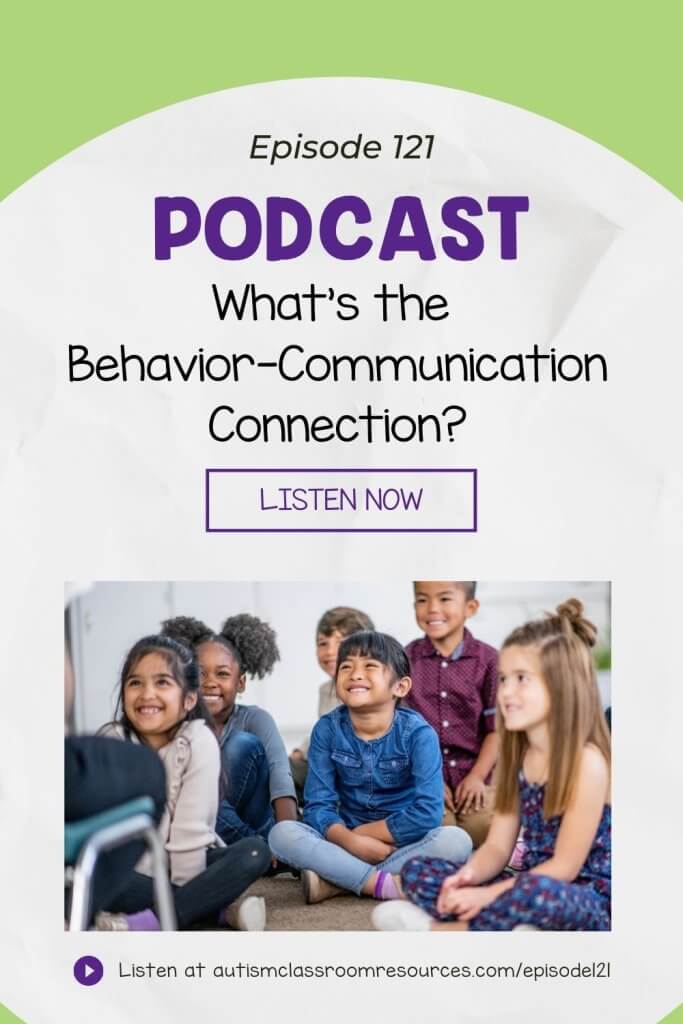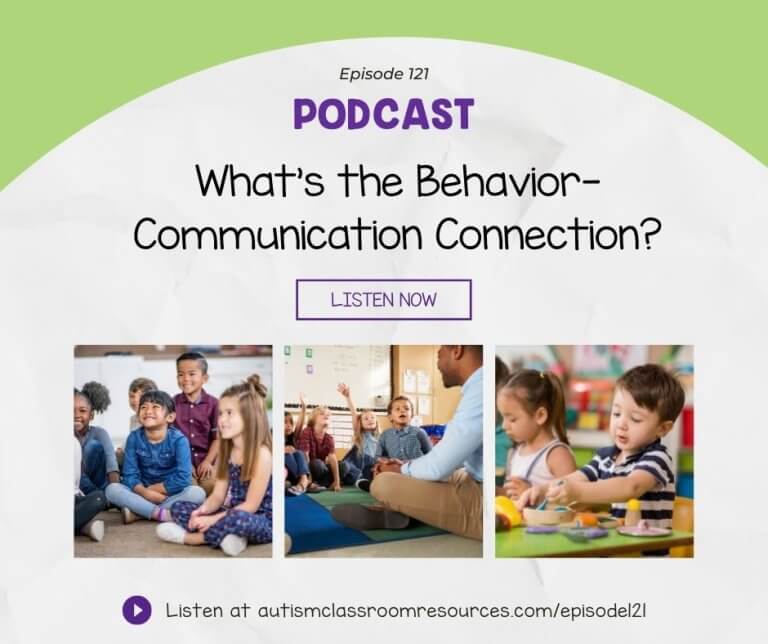Welcome to the Autism Classroom Resources Podcast, the podcast for special educators who are looking for personal and professional development.
Christine Reeve: I’m your host, Dr. Christine Reeve. For more than 20 years, I’ve worn lots of hats in special education but my real love is helping special educators like you. This podcast will give you tips and ways to implement research-based practices in a practical way in your classroom to make your job easier and more effective.
Hello. Welcome back to the Autism Classroom Resources Podcast. I am Christine Reeve and I’m your host. I’m so glad that you’re here today as we switch gears in a new month to talk about the relationship between communication and behavior. Now, I am willing to bet that many, if not all of you, have heard someone say, or perhaps you said it yourself, something like, “Well, behavior is communication,” or “His challenging behavior is that he’s trying to communicate,” or some other kind of reference that shows a connection between communication and behavior.
For some, that might be very clear and it might have something to do with something that you’ve had training on or heard about in school but I’m willing to bet that for many of you, in the back of your head, you were thinking that slap or that hair pull or that bite didn’t feel too much like any communication that you had heard in the past. Am I right? You might have wondered exactly what that person was trying to sell you, like maybe talk thing, it was communication that made it okay, because that’s what that always sounds like.
Since May is traditionally a Better Hearing & Speech Month, I thought I would make this month’s theme the connection between communication and behavior because there is a very strong connection between the two. But no, we don’t think that you have to let him talk to you by hitting. Don’t worry, that’s not where this is going.
Now, if you are one of those who know all about the connection between communication and behavior, that’s awesome. Tell your friends. You might find some tidbits in today’s episode and in the rest of the month that will help others see the importance and make your life a little easier because I don’t know about you, but I’m always looking for ways to reach people about the importance of how these two go together and helping them see the connection. But these episodes might also be great options to share with your paraprofessionals, with the families that you work with to help them see the connection as well.
I’m going to kick off today by talking about some of the research and what we know about how communication impacts behavior, and how behavior grows out of communication deficits. I’ll talk about what that means for interventions as well. I’ve got episodes lined up to talk about what positive behavioral support really is because, hint, it sometimes gets twisted around. I want you to keep an open mind if you really have not had positive experiences with positive behavioral support.
I have another one on functional communication training where behaviors seem to be related to things like anxiety fits into all this communication stuff and what to do when your behavior plan that’s based on all this communication stuff isn’t really working. I think it’s going to be a pretty fun month. It’s probably because I’m a behavior analyst and I love challenges. I really love the behavior communication connection.
Speaking of challenges, are you feeling challenged by everything this year has thrown at you? I think most of us are. Did you know that I have an online academy that has tons of tools and strategies that you can access as you need them to help you make your life easier, and hopefully give you more out of the classroom life? If you want to take back more of your life outside the classroom and feel more relaxed and confident in the classroom, come check out the Special Educator Academy. Grab your seven-day free trial at specialeducatoracademy.com. If you decide that it’s something you’d like and stay on pasture trial period, you’ll get a free session with me to help plan your path to make the most of your stay with us. Now, let’s get started.
The relationship between behavior and communication goes back probably more than 50 years, but the literature over the past 50 years in the development of children in typical, without handicaps, demonstrates that certain nonverbal forms of behavior in infancy, including crying and hitting, have communicative intention. Those of you who are moms and dads have recognized that your infants cry, and you can begin to tell what kind of cry indicates what kind of problems.
We also see that primitive behaviors are used by typical young children to modify others’ behaviors, thereby, they’re communicating. For instance, a two year old will walk over to appear and hit him on the head with a stuffed animal. That’s an indication that he wants to play with that kid, but three year olds don’t do that as much. One of the reasons is their language has improved so much that they say to the kid, “Play” or “Here.” They’ll say something instead of using that physical interaction.
Most children develop communication skills during that time that replace those behaviors but our students with developmental disabilities don’t develop those skills. That’s one of the reasons why we see these behaviors continue. As they get older, they become problems, partly because they’re not age appropriate, they’re not developmentally the norm for that age, and partly because we as adults start to ignore those behaviors as a way to try to make them go away, so the behaviors escalate because they’re not working anymore.
Correlational studies have shown that language impaired children exhibit more behavior problems than typical kids their age. That’s actually a research that comes from Coffield, Fishel, and colleagues in ‘89, Stevenson and Richmond from ‘78. I mean, it’s research that goes back a long way. Typical and language-delayed children have been shown to exhibit more problem behaviors when they’re placed in situations that were communicatively difficult for them rather than ones in which their communication skills were sufficient for the task. That came out of Russ Whitehurst lab with Marie Coffield in 1989 where when they placed children in situations where their communication skills weren’t effective, both the typical and the language-delayed children resorted to behavior problems.
You see the airport all the time. When people are not getting a response from airline officials when their planes are delayed, you get problem behavior. It happens not just with kids. My master’s project back in the 1980s, early 90s also found this. We had children who used communication that was interpretable to the listener to make a request. That was interpretable because we interpreted it. We told the listener what that sign meant. Their request was met accurately and quickly. That meant it was efficient at getting what they wanted. They used a sign that was understood by the listener and they got what they wanted, so they didn’t have a lot of challenging behaviors.
But when they used a communication strategy that was less efficient, it was not interpretable, it was an unusual sign, and that wasn’t told what it meant, then the adult didn’t understand, they didn’t respond quickly, and they didn’t respond correctly. They went through a whole bunch of items trying to figure out what the kid wanted, then we saw more behavior problems. It doesn’t seem really Earth shattering but it really did show between those two groups, that when the communication strategies don’t work, that’s when we see more behaviors.
When I talk about functional communication training in a couple weeks, we’ll talk more about it but you can learn more about it in Episode 98 where I talked about the characteristics of choosing a replacement strategy for behavior. That’s in autismclassroomresources.com/episode98, or directly, there have been some experimental studies that for individuals with developmental disabilities, increases in functional communication competence leads to decreases in problem behavior.
Carr & Durand showed that when you taught individuals specific phrases that served the same function as their problem behaviors, those problem behaviors got better. [Connor & Budd] in ’85 showed that if you taught the individual specific communication responses that got the need met efficiently, quickly, easily, and more effectively, their behaviors were much less than if you taught them a skill that was less efficient. We have a number of studies that show that it can actually replace that behavior and that’s the beginning of our research in functional communication training, which I’ll talk about in two weeks.
Similarly, we also found with the Carr & Durand study that it is the specific thing we teach. It’s not enough just to teach any old communication. We have to actually teach something that serves a function. If there were children whose behavior served to escape from a task, teaching them to say, “Am I doing good work?” and have somebody just say, “Yeah, you’re doing a good job,” was not enough. The behaviors continued. Similarly, if we had children whose behavior was to get attention, teaching them to say, “I need help,” was not enough because they weren’t getting enough attention. That’s the underlying piece that really began the research in functional communication training.
Speaking of functional communication training, what exactly is it? We will give you a really quick rundown because I will spend more time on the real details of how we do it in the classroom later in the episode. But Carr & Durand study began it, and functional communication training focuses on teaching communication skills that match the functions. It could include teaching a student to ask for a break, request attention appropriately, and ask for help. It indicates that they don’t feel well.
We have research that shows the increased communication skills in those areas have been linked to decrease in challenging behaviors. As the communication skills increased, negative behaviors decreased. In addition, my dissertation actually showed that we could teach proactively those skills and we could decrease the escalation of problem behaviors that were related to those same functions. It’s the beginning of being able to have a skill that we can teach proactively to prevent behavior from increasing.
FCT has been found to be a well established treatment for problem behavior exhibited by children with intellectual disability and children with autism spectrum disorder, and it’s characterized to be probably efficacious with adults as well. It covers a wide population of students. It specifically focuses on communication. It really gets at the heart of this communication, behavior connection.
That brings us to, I hope, some understanding of the communicative underpinnings of challenging behavior. Next week, I will be back to talk a bit about positive behavioral support and what it really is, then I’ll circle back and I’ll talk about what we need to know about how to implement functional communication training the next week. I’m really excited for this month because obviously, this is one of my favorite topics.
I’d love to know if you have questions or areas that you’d like to know more about. If you do, feel free to email me at ch***@**********************es.com. Don’t forget to grab your free trial of the academy at specialeducatoracademy.com. You can find the transcript and lots of free resources in the FREE Resource Library at autismclassroomresources.com/episode121. I hope that you have an amazing week this week and that you’ll be back next week for our next episode.






